Analysis of Honeybee Drone Activity during the Mating Season in Northwestern Argentina
Abstract
:Simple Summary
Abstract
1. Introduction
2. Materials and Methods
2.1. Direct Observations at the Hive’s Entrance
2.2. Use of Radio Frequency Identification Tags
2.3. Departure & Arrival Detection Using RFIDs
- If the drones leave and enter the hive frequently, i.e., between 1 s and 3 min, they are exiting to defecate or beard (see Figure 2) and entering to feed.
- If the drones remain inside the hive for more than 30 min, they are resting or waiting for climatic conditions to improve.
- If the drones leave the hive for a period of 3 to 10 min, they are performing orientation flights.
- If the drones leave the hive for a period of 10 min to 10 h, they are searching for or staying at the DCA.
- If the drones are undetected again, they are dead or mated, or disoriented.
2.4. Reproducibility & Renewability of the Analysis
3. Results
3.1. Direct Observations at the Hive’s Entrance and Video Recording
3.2. Scanning with RFIDs
3.3. Comparing Methods
4. Discussion
5. Conclusions
Supplementary Materials
Author Contributions
Funding
Institutional Review Board Statement
Informed Consent Statement
Data Availability Statement
Acknowledgments
Conflicts of Interest
References
- Bartz, S.H. On the evolution of male workers in the Hymenoptera. Behav. Ecol. Sociobiol. 1982, 11, 223–228. [Google Scholar] [CrossRef]
- Beani, L.; Dessi-Fulgheri, F.; Cappa, F.; Toth, A. The trap of sex in social insects: From the female to the male perspective. Neurosc. Biobehav. Rev. 2014, 46, 519–533. [Google Scholar] [CrossRef] [PubMed]
- Heinze, J. The male has done his work—The male may go. Curr. Opin. Insect Sci. 2016, 16, 22–27. [Google Scholar] [CrossRef] [PubMed]
- Ruttner, F. The life and flight activity of drones. Bee World 1966, 47, 93–100. [Google Scholar] [CrossRef]
- Rangel, J.; Fisher, A. Factors affecting the reproductive health of honey bee (Apis mellifera) drones—A review. Apidologie 2019, 50, 759–778. [Google Scholar] [CrossRef] [Green Version]
- Koeniger, N.; Koeniger, G.; Pechhacker, H. The nearer the better? Drones (Apis mellifera) prefer nearer drone congregation areas. Insectes Soc. 2005, 52, 31–35. [Google Scholar] [CrossRef]
- Free, J. The drifting of honey-bees. J. Agric. Sci. 1958, 51, 294–306. [Google Scholar] [CrossRef]
- Burgett, D.M. Drone engorgement in honey bee swarms. Ann. Entomol. Soc. Am. 1973, 66, 1005–1006. [Google Scholar] [CrossRef] [Green Version]
- Galindo-Cardona, A.; Monmany, A.C.; Diaz, G.; Giray, T. A landscape analysis to understand orientation of honey bee (Hymenoptera: Apidae) drones in Puerto Rico. Environ. Entomol. 2015, 44, 1139–1148. [Google Scholar] [CrossRef]
- Galindo-Cardona, A.; Monmany, C.; Moreno-Jackson, R.; Rivera-Rivera, C.; Huertas-Dones, C.; Caicedo-Quiroga, L.; Giray, T. Landscape analysis of drone congregation areas of the honey bee, Apis mellifera. J. Insect Sci. 2012, 2, 122. [Google Scholar] [CrossRef] [Green Version]
- Koeniger, N.; Koeniger, G. Mating behavior in honey bees (Genus Apis). Trop. Agric. Res. Ext. 2004, 7, 13–28. [Google Scholar]
- Galindo-Cardona, A.; Scannapieco, A.C.; Russo, R.; Escalante, K.; Geria, M.; Lepori, N.; Ayup, M.M.; Muntaabski, I.; Liendo, M.C.; Landi, L.; et al. Varroa destructor parasitism and genetic variability at honey bee (Apis mellifera) drone congregation areas and their associations with environmental variables in Argentina. Front. Ecol. Evol. 2020, 8, 394. [Google Scholar] [CrossRef]
- Ikegami, K.; Yoshimura, T. Seasonal time measurement during reproduction. J. Reprod. Dev. 2013, 59, 327–333. [Google Scholar] [CrossRef] [PubMed] [Green Version]
- Moore, D.; Angel, J.E.; Cheeseman, I.M.; Fahrbach, S.E.; Robinson, G.E. Timekeeping in the honey bee colony: Integration of circadian rhythms and division of labor. Behah. Ecol. Sociobiol. 1998, 43, 147–160. [Google Scholar] [CrossRef]
- Bloch, G.; Robinson, G.E. Reversal of honeybee behavioural rhythms. Nature 2001, 410, 1048. [Google Scholar] [CrossRef] [PubMed]
- Giannoni-Guzmán, M.A.; Avalos, A.; Perez, J.M.; Loperena, E.J.O.; Medina, J.A.; Massey, S.E.; Kence, M.; Kence, A.; Giray, T.; Agosto-Rivera, J.L. Measuring individual locomotor rhythms in honey bees, paper wasps and other similar-sized insects. J. Exp. Biol. 2014, 217, 1307–1315. [Google Scholar] [CrossRef] [Green Version]
- Kovac, H.; Stabentheiner, A.; Brodschneider, R. Contribution of honeybee drones of different age to colonial thermoregulation. Apidologie 2009, 40, 82–95. [Google Scholar] [CrossRef] [PubMed] [Green Version]
- Currie, R.W. The biology and behaviour of drones. Bee World 1987, 68, 129–143. [Google Scholar] [CrossRef]
- Von Frisch, K. Decoding the language of the bee. Science 1974, 185, 663–668. [Google Scholar] [CrossRef] [Green Version]
- Reyes, M.; Crauser, D.; Prado, A.; Conte, Y.L. Flight activity of honey bee (Apis mellifera) drones. Apidologie 2019, 50, 669–680. [Google Scholar] [CrossRef]
- Loper, G.; Wolf, W.; Taylor, O. Honey bee drone flyways and congregation areas: Radar observations. J. Kans. Entomol. Soc. 1992, 65, 223–230. [Google Scholar]
- Riley, J.; Greggers, U.; Smith, A.; Reynolds, D.R.; Menzel, R. The flight paths of honeybees recruited by the waggle dance. Nature 2005, 435, 205–207. [Google Scholar] [CrossRef]
- Van Geystelen, A.; Benaets, K.; Graaf, D.C.D.; Larmuseau, M.H.D.; Wensellers, T. Track-a-forager: A program for the automated analysis of RFID tracking data to reconstruct foraging behaviour. Insect Soc. 2016, 63, 175–183. [Google Scholar] [CrossRef]
- Souza, P.D.; Marendy, P.; Barbosa, K.; Budi, S.; Hirsch, P.; Nikolic, N.; Gunthorpe, T.; Pessin, G.; Davie, A. Low-cost electronic tagging system for bee monitoring. Sensors 2018, 18, 2124. [Google Scholar] [CrossRef] [PubMed] [Green Version]
- Nunes-Silva, P.; Hrncir, M.; Guimarães, J.T.F.; Arruda, H.; Costa, L.; Pessin, G.; Siqueira, J.O.; Souza, P.D.; Imperatriz-Fonseca, V.L. Applications of RFID technology on the study of bees. Insects Soc. 2019, 66, 15–24. [Google Scholar] [CrossRef]
- Nunes-Silva, P.; Costa, L.; Campbell, A.J.; Contrera, F.A.L.; Teixeira, J.S.G.; Gomes, R.L.C.; Pessin, G.; Pereira, D.S.; Souza, P.D.; Imperatriz-Fonseca, V.L. Radio frequency identification (RFID) reveals long distance flight and homing abilities of the stingless bee Melipona fasciculata. Apidologie 2020, 51, 240–253. [Google Scholar] [CrossRef] [Green Version]
- Gomes, P.A.B.; Suhara, Y.; Nunes-Silva, P.; Costa, L.; Arruda, H.; Venturieri, G.; Imperatriz-Fonseca, V.L.; Pentland, A.; Souza, P.D.; Pessin, G. An Amazon stingless bee foraging activity predicted using recurrent artificial neural networks and attribute selection. Nat. Sci. Rep. 2020, 10, 9. [Google Scholar] [CrossRef] [PubMed] [Green Version]
- Heidinger, I.M.M.; Meixner, M.D.; Berg, S.; Büchler, R. Observation of the mating behavior of honey bee (Apis mellifera L.) queens using radio-frequency identification (RFID): Factors influencing the duration and frequency of nuptial flights. Insects 2014, 5, 513–527. [Google Scholar] [CrossRef] [Green Version]
- Agra, M.N.; Conte, C.A.; Corva, P.M.; Cladera, J.L.; Lanzavecchia, S.B.; Palacio, M.A. Molecular characterization of Apis mellifera colonies from Argentina: Genotypic admixture associated with ecoclimatic regions and apicultural activities. Entomol. Exp. Appl. 2018, 166, 724–738. [Google Scholar] [CrossRef]
- Grau, H.R.; Gasparri, N.I.; Aide, T.M. Agriculture expansion and deforestation in seasonally dry forests of north-west Argentina. Environ. Conserv. 2005, 32, 140–148. [Google Scholar] [CrossRef]
- Cobey, S.W.; Tarpy, D.R.; Woyke, J. Standard methods for instrumental insemination of Apis mellifera queens. J. Apic. Res. 2013, 52, 1–18. [Google Scholar] [CrossRef] [Green Version]
- Susanto, F.; Gillard, T.; Souza, P.D.; Vincent, B.; Budi, S.; Almeida, A.; Pessin, G.; Arruda, H.; Williams, R.N.; Engelke, U.; et al. Addressing RFID misreadings to better infer bee hive activity. IEEE Access 2018, 6, 31935–31949. [Google Scholar] [CrossRef]
- R Core Team. R: A Language and Environment for Statistical Computing; R Foundation for Statistical Computing: Vienna, Austria, 2017; Available online: https://www.R-project.Org (accessed on 5 January 2008).
- Toppa, R.H.; Arena, M.V.N.; Silva, C.I.D.; Marendy, P.; Souza, P.D.; Silva-Zacarin, E.C.M.D. Impact of glues used for RFIDs on the longevity and flight muscles of the stingless bee Melipona quadrifasciata (Apidae: Meliponini). Apidologie 2020, 52, 328–340. [Google Scholar] [CrossRef]
- Desoil, M.; Gillis, P.; Gossuin, Y.; Pankhurst, Q.A.; Hautot, D. Definitive identification of magnetite nanoparticles in the abdomen of the honeybee Apis mellifera. J. Phys. Conf. Ser. 2005, 17, 45–49. [Google Scholar] [CrossRef]
- Duay, P.; Jong, D.D.; Engels, W. Decreased flight performance and sperm production in drones of the honeybee (Apis mellifera) slightly infested by Varroa destructor mites during pupal development. Genet. Mol. Res. 2002, 1, 227–232. [Google Scholar] [PubMed]
- Neumann, P.; Moritz, R.F.A.; Mautz, D. Colony evaluation is not affected by drifting of drone and worker honeybees (Apis mellifera L.) at a performance testing apiary. Apidologie 2000, 31, 67–79. [Google Scholar] [CrossRef] [Green Version]
- Kovac, H.; Stabentheiner, A. Thermoregulation of foraging honeybees on flowering plants: Seasonal variability and influence of radiative heat gain. Ecol. Entomol. 2011, 36, 686–699. [Google Scholar] [CrossRef] [Green Version]
- Rowel, G.A. Variation in drone mating flight times among commercial honey bee stocks. Apidologie 1986, 17, 137–158. [Google Scholar] [CrossRef] [Green Version]
- Ruttner, F. The mating of the honey bee. Bee World 1956, 37, 3–15. [Google Scholar] [CrossRef]
- Taber, S. Factors influencing the circadian flight rhythm of drone honey bees. Ann. Entomol. Soc. Am. 1964, 57, 769–775. [Google Scholar] [CrossRef]
- Giannoni-Guzmán, M.A.; Rivera, E.; Aleman-Rios, J.; Melendez, A.M.; Moreno, M.; Perez Ramos, D.L.; Moore, D.; Giray, T.; Agosto-Rivera, J.L. The role of colony temperature in the entrainment of circadian rhythms of honey bee foragers. bioRxiv 2020. [Google Scholar] [CrossRef]
- Fahrenholz, L.; Lamprecht, I.; Schricker, B. Thermal investigations of a honey bee colony: Thermoregulation of the hive during summer and winter and heat production of members of different bee castes. J. Comp. Physiol. B 1989, 159, 551–560. [Google Scholar] [CrossRef]
- Winston, M.L. The Biology of the Honey Bee; Harvard University Press: Cambridge, MA, USA, 1987. [Google Scholar]
- Bloch, G.; Dan, P.T.; Robinson, G.E. Behavioral rhythmicity, age, division of labor and period expression in the honey bee brain. J. Biol. Rhythms 2001, 16, 444–456. [Google Scholar] [CrossRef] [PubMed]
- Majercak, J.; Sidote, D.; Hardin, P.E.; Edery, I. How a circadian clock adapts to seasonal decreases in temperature and day length. Neuron 1999, 24, 219–230. [Google Scholar] [CrossRef] [Green Version]
- Yoshii, T.; Rieger, D.; Helfrich-Förster, C. Two clocks in the brain: An update of the morning and evening oscillator model in Drosophila. Prog. Brain. Res. 2012, 199, 59–82. [Google Scholar] [CrossRef] [PubMed]
- Hamasaka, Y.; Suzuki, T.; Hanai, S.; Ishida, N. Evening circadian oscillator as the primary determinant of rhythmic motivation for Drosophila courtship behaviour. Genes Cells 2010, 15, 1240–1248. [Google Scholar] [CrossRef] [PubMed]
- Koeniger, N.; Wijayagunasekera, H.N.P. Time of drone flight in the three Asiatic honeybee species (Apis cerana, Apis florea, Apis dorsata). J. Apic. Res. 1976, 15, 67–71. [Google Scholar] [CrossRef]
- Howell, D.E.; Usinger, R.L. Observations on the flight and length of life of drone bees. Ann. Entomol. Soc. Am. 1933, 26, 239–246. [Google Scholar] [CrossRef]
- Oertel, E. Mating flights of queen bees. Glean. Bee Cult. 1940, 68, 292–293. [Google Scholar]
- Oertel, E. Observations on the flight of drone honey bees. Ann. Entomol. Soc. Am. 1956, 49, 497–500. [Google Scholar] [CrossRef]
- Minderhoud, A. Recent research. Bee World 1932, 13, 66. [Google Scholar]
- Koeniger, N.; Hemmling, C.; Yoshida, T. Drones as sons of drones in Apis mellifera. J. Apic. Res. 1989, 20, 391–394. [Google Scholar] [CrossRef] [Green Version]
- Lensky, Y.; Cassier, P.; Nutkin, M. Pheromonal activity and fine structure of the mandibular glands of the honeybee drones (Apis mellifera L.) (Insecta, Hymenoptera, Apidae). J. Insect Phys. 1985, 31, 265–276. [Google Scholar] [CrossRef]
- Galindo-Cardona, A.; Quiroga, O.B.; Bianchi, E.; Ayup, M.M. Primer reporte de un área de congregación de zánganos de Apis mellifera (Hymenoptera: Apidae) de Argentina. Rev. Soc. Entomol. Arg. 2017, 76, 50–53. [Google Scholar] [CrossRef]
- Hellmich, R.L.; Rinderer, T.E.; Danka, R.G.; Collins, A.M.; Boykin, D.L. Flight times of Africanized and European honey bee drones (Hymenoptera: Apidea). J. Econ. Entomol. 1991, 84, 61–64. [Google Scholar] [CrossRef]
- Muerrle, T.M.; Hepburn, H.R.; Radloff, S.E. Experimental determination of drone congregation areas for Apis mellifera capensis Esch. J. Apic. Res. 2007, 46, 154–159. [Google Scholar] [CrossRef]
- Jordan, L.A.; Allsopp, M.H.; Oldroyd, B.P.; Wossler, T.C.; Beekman, M. A Scientific note on the drone flight time of Apis mellifera capensis and A. scutellata. Apidologie 2007, 38, 436–437. [Google Scholar] [CrossRef]
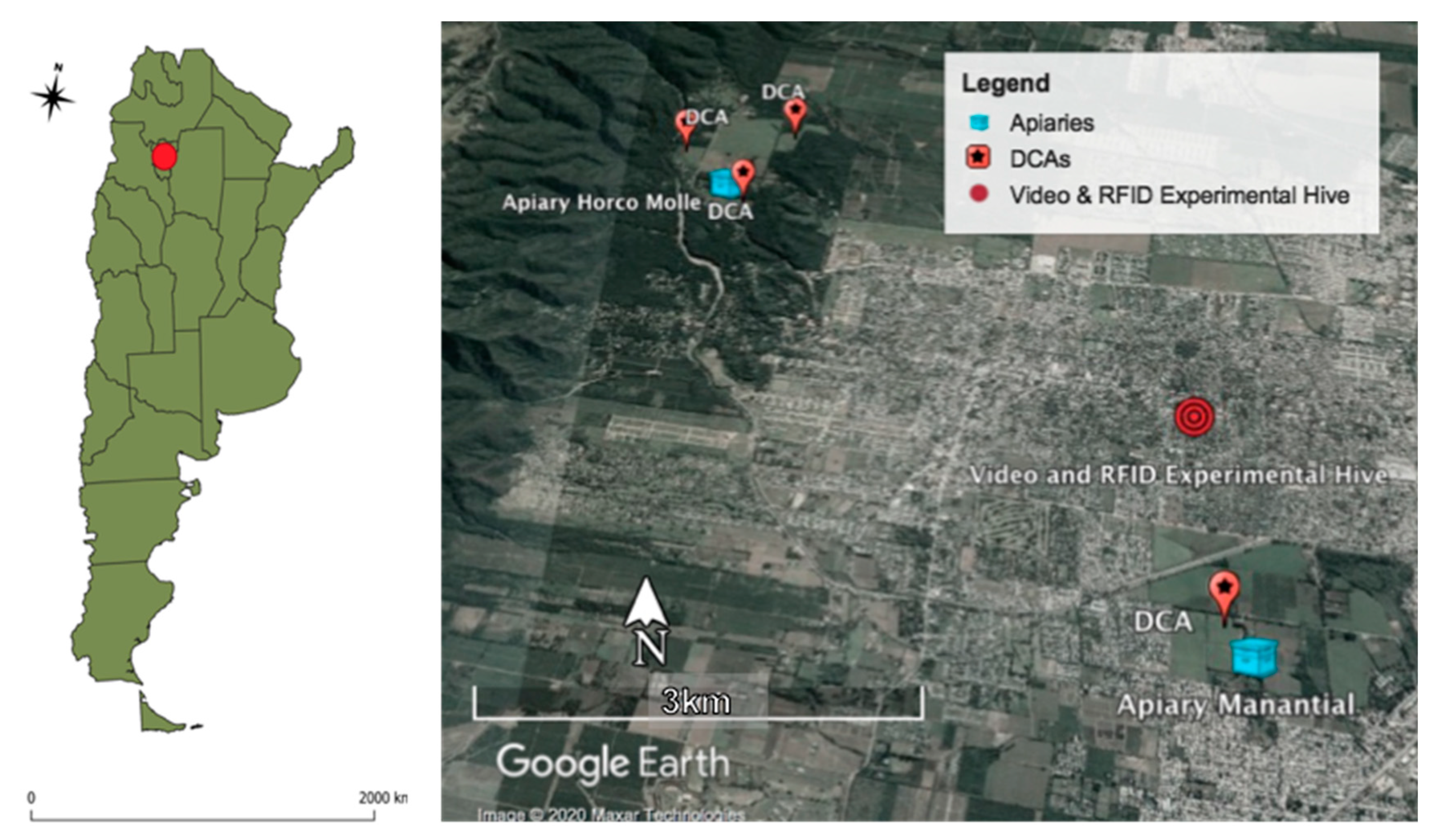
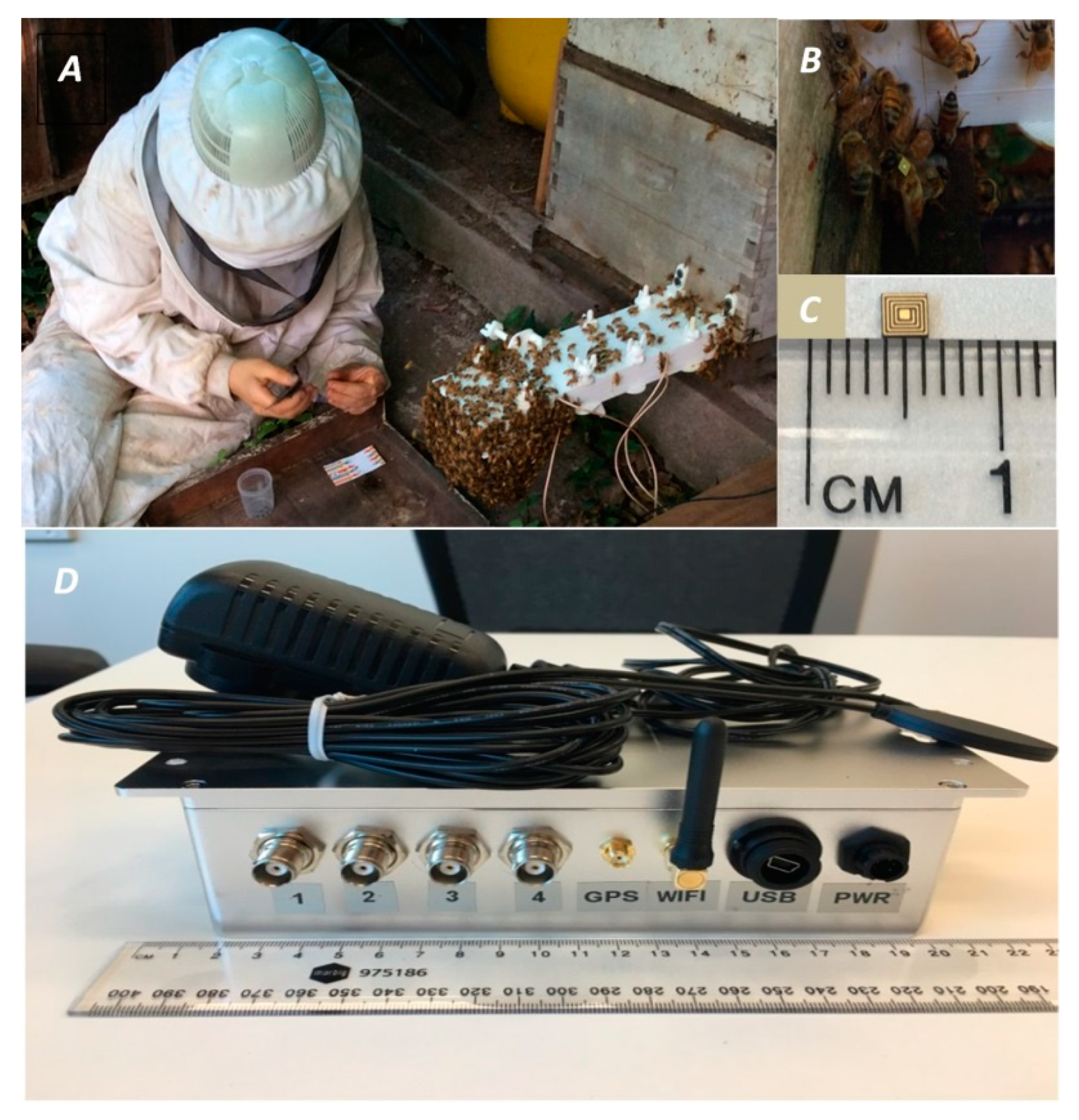

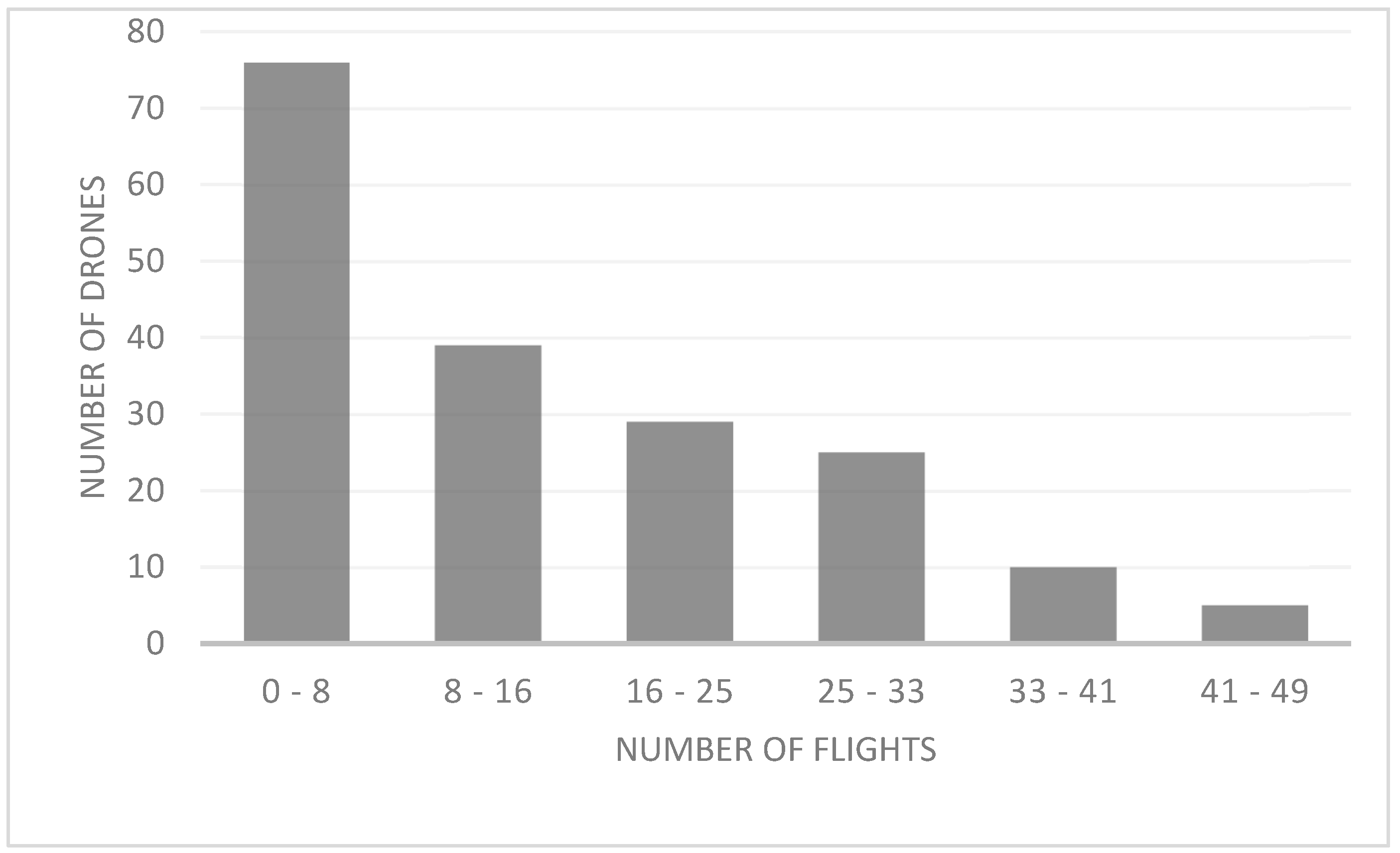
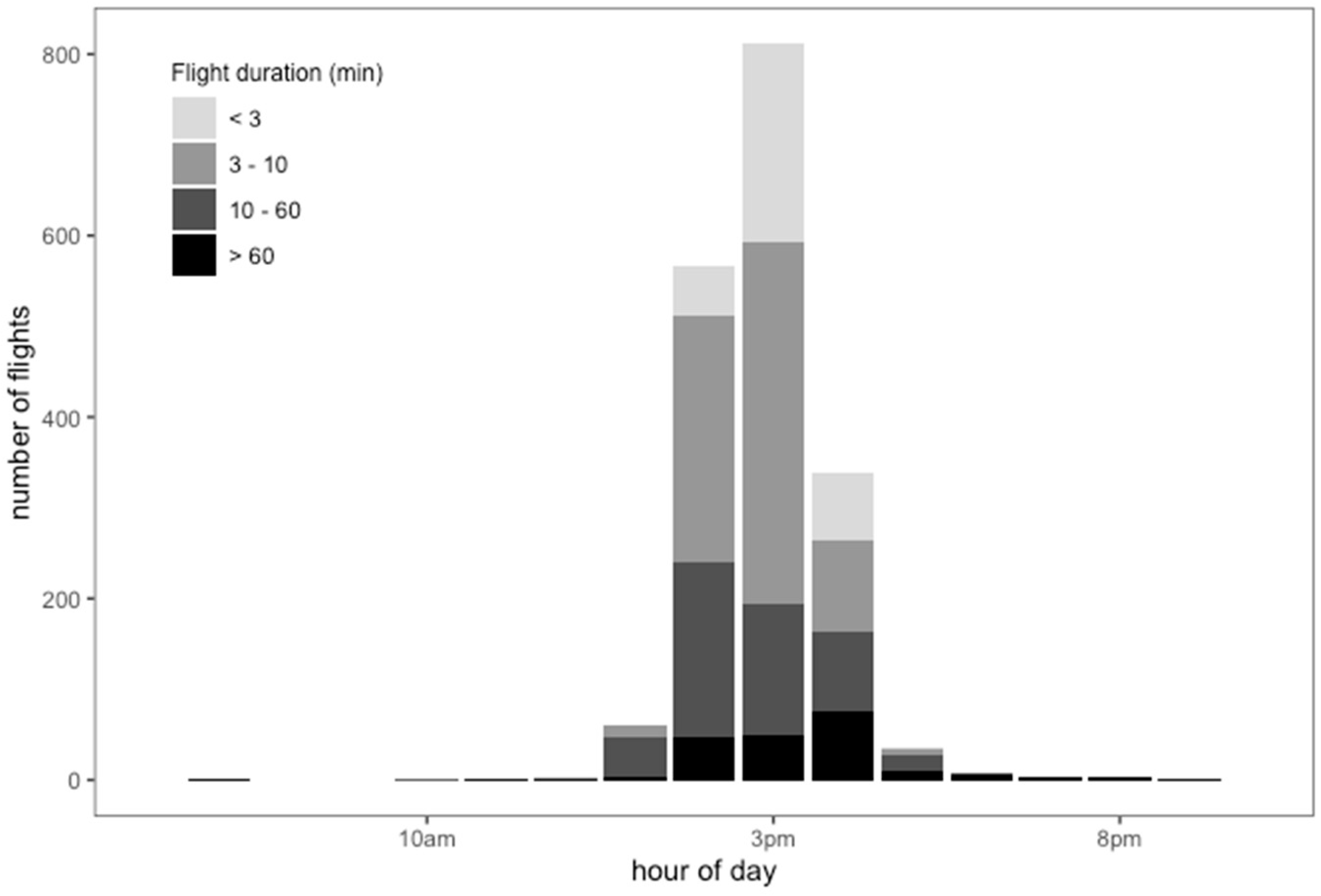
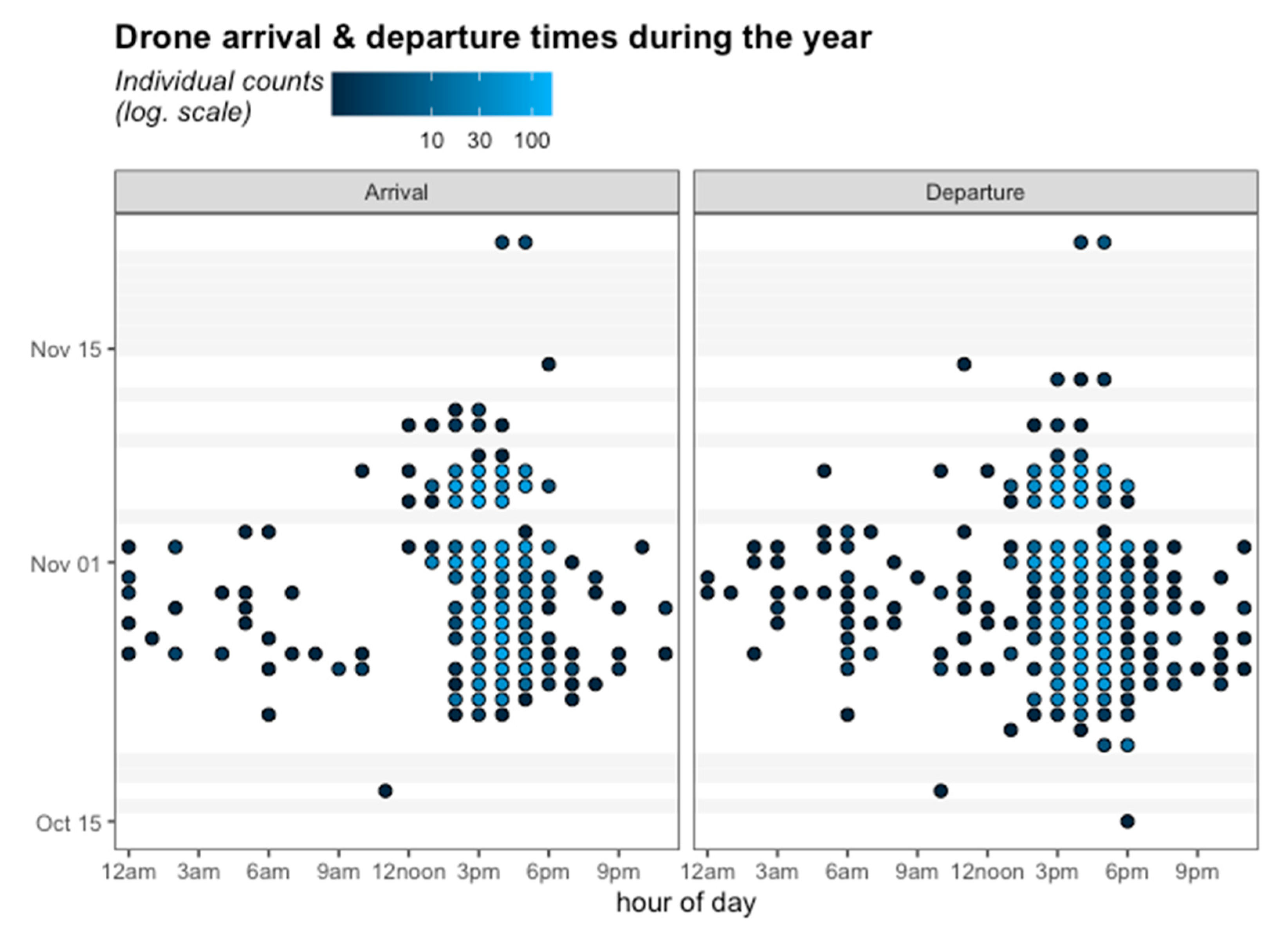
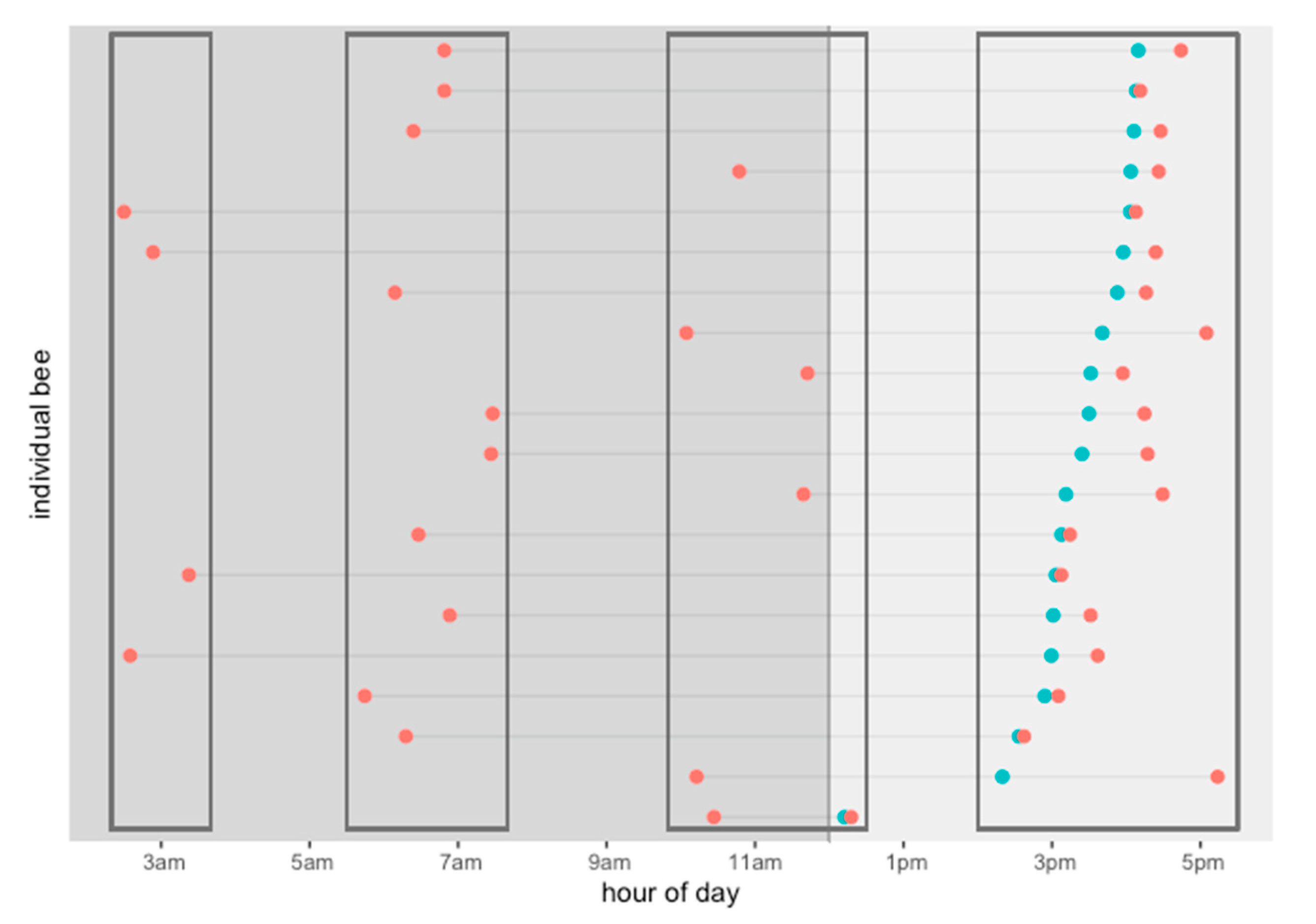
| Drone Behavior | Activities | Threshold | Duration | Frequency |
|---|---|---|---|---|
| Exit/Entry | High frequency readings, defecation, beards, feeding | x 3 min | 1 sec < x 3 min | High |
| Resting | Inside the beehive, e.g., climate | x 30 min | 30 min < x 10 h | High |
| Short mission | Orientation flights, walking outside around the hive | 3 min < x 10 min | 3 min < x 10 min | Medium |
| Scouting | Visiting or scouting for new drone congregation areas | x > 10 min | 10 min < x 10 h | Low-Medium |
| Departed drone | Last detection of an individual, e.g., drone mating | - | - | High |
| Methods | Strengths | Limitations |
|---|---|---|
| Direct visual observation at the hive’s entrance |
|
|
| Indirect visual observation (via camera) |
|
|
| Electronic tagging (via RFID) |
|
|
Publisher’s Note: MDPI stays neutral with regard to jurisdictional claims in published maps and institutional affiliations. |
© 2021 by the authors. Licensee MDPI, Basel, Switzerland. This article is an open access article distributed under the terms and conditions of the Creative Commons Attribution (CC BY) license (https://creativecommons.org/licenses/by/4.0/).
Share and Cite
Ayup, M.M.; Gärtner, P.; Agosto-Rivera, J.L.; Marendy, P.; de Souza, P.; Galindo-Cardona, A. Analysis of Honeybee Drone Activity during the Mating Season in Northwestern Argentina. Insects 2021, 12, 566. https://doi.org/10.3390/insects12060566
Ayup MM, Gärtner P, Agosto-Rivera JL, Marendy P, de Souza P, Galindo-Cardona A. Analysis of Honeybee Drone Activity during the Mating Season in Northwestern Argentina. Insects. 2021; 12(6):566. https://doi.org/10.3390/insects12060566
Chicago/Turabian StyleAyup, Maria Marta, Philipp Gärtner, José L. Agosto-Rivera, Peter Marendy, Paulo de Souza, and Alberto Galindo-Cardona. 2021. "Analysis of Honeybee Drone Activity during the Mating Season in Northwestern Argentina" Insects 12, no. 6: 566. https://doi.org/10.3390/insects12060566







